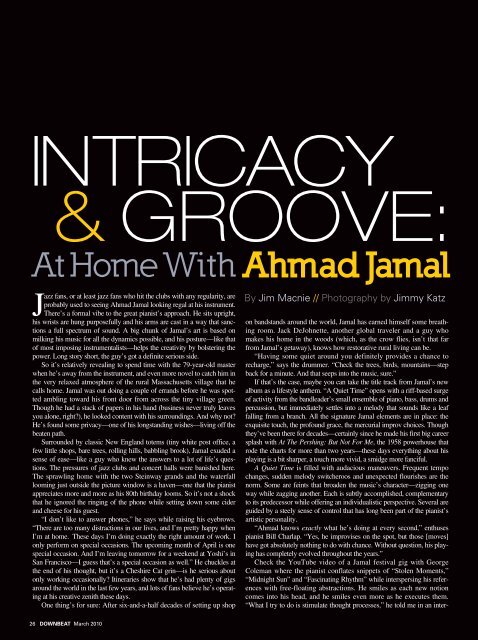Download - Downbeat
Download - Downbeat
Download - Downbeat
You also want an ePaper? Increase the reach of your titles
YUMPU automatically turns print PDFs into web optimized ePapers that Google loves.
INTRICACY<br />
& GROOVE:<br />
At Home With Ahmad Jamal<br />
Jazz fans, or at least jazz fans who hit the clubs with any regularity, are<br />
probably used to seeing Ahmad Jamal looking regal at his instrument.<br />
There’s a formal vibe to the great pianist’s approach. He sits upright,<br />
his wrists are hung purposefully and his arms are cast in a way that sanctions<br />
a full spectrum of sound. A big chunk of Jamal’s art is based on<br />
milking his music for all the dynamics possible, and his posture—like that<br />
of most imposing instrumentalists—helps the creativity by bolstering the<br />
power. Long story short, the guy’s got a definite serious side.<br />
So it’s relatively revealing to spend time with the 79-year-old master<br />
when he’s away from the instrument, and even more novel to catch him in<br />
the very relaxed atmosphere of the rural Massachusetts village that he<br />
calls home. Jamal was out doing a couple of errands before he was spotted<br />
ambling toward his front door from across the tiny village green.<br />
Though he had a stack of papers in his hand (business never truly leaves<br />
you alone, right?), he looked content with his surroundings. And why not?<br />
He’s found some privacy—one of his longstanding wishes—living off the<br />
beaten path.<br />
Surrounded by classic New England totems (tiny white post office, a<br />
few little shops, bare trees, rolling hills, babbling brook), Jamal exuded a<br />
sense of ease—like a guy who knew the answers to a lot of life’s questions.<br />
The pressures of jazz clubs and concert halls were banished here.<br />
The sprawling home with the two Steinway grands and the waterfall<br />
looming just outside the picture window is a haven—one that the pianist<br />
appreciates more and more as his 80th birthday looms. So it’s not a shock<br />
that he ignored the ringing of the phone while setting down some cider<br />
and cheese for his guest.<br />
“I don’t like to answer phones,” he says while raising his eyebrows.<br />
“There are too many distractions in our lives, and I’m pretty happy when<br />
I’m at home. These days I’m doing exactly the right amount of work. I<br />
only perform on special occasions. The upcoming month of April is one<br />
special occasion. And I’m leaving tomorrow for a weekend at Yoshi’s in<br />
San Francisco—I guess that’s a special occasion as well.” He chuckles at<br />
the end of his thought, but it’s a Cheshire Cat grin—is he serious about<br />
only working occasionally? Itineraries show that he’s had plenty of gigs<br />
around the world in the last few years, and lots of fans believe he’s operating<br />
at his creative zenith these days.<br />
One thing’s for sure: After six-and-a-half decades of setting up shop<br />
By Jim Macnie // Photography by Jimmy Katz<br />
on bandstands around the world, Jamal has earned himself some breathing<br />
room. Jack DeJohnette, another global traveler and a guy who<br />
makes his home in the woods (which, as the crow flies, isn’t that far<br />
from Jamal’s getaway), knows how restorative rural living can be.<br />
“Having some quiet around you definitely provides a chance to<br />
recharge,” says the drummer. “Check the trees, birds, mountains—step<br />
back for a minute. And that seeps into the music, sure.”<br />
If that’s the case, maybe you can take the title track from Jamal’s new<br />
album as a lifestyle anthem. “A Quiet Time” opens with a riff-based surge<br />
of activity from the bandleader’s small ensemble of piano, bass, drums and<br />
percussion, but immediately settles into a melody that sounds like a leaf<br />
falling from a branch. All the signature Jamal elements are in place: the<br />
exquisite touch, the profound grace, the mercurial improv choices. Though<br />
they’ve been there for decades—certainly since he made his first big career<br />
splash with At The Pershing: But Not For Me, the 1958 powerhouse that<br />
rode the charts for more than two years—these days everything about his<br />
playing is a bit sharper, a touch more vivid, a smidge more fanciful.<br />
A Quiet Time is filled with audacious maneuvers. Frequent tempo<br />
changes, sudden melody switcheroos and unexpected flourishes are the<br />
norm. Some are feints that broaden the music’s character—zigging one<br />
way while zagging another. Each is subtly accomplished, complementary<br />
to its predecessor while offering an individualistic perspective. Several are<br />
guided by a steely sense of control that has long been part of the pianist’s<br />
artistic personality.<br />
“Ahmad knows exactly what he’s doing at every second,” enthuses<br />
pianist Bill Charlap. “Yes, he improvises on the spot, but those [moves]<br />
have got absolutely nothing to do with chance. Without question, his playing<br />
has completely evolved throughout the years.”<br />
Check the YouTube video of a Jamal festival gig with George<br />
Coleman where the pianist conflates snippets of “Stolen Moments,”<br />
“Midnight Sun” and “Fascinating Rhythm” while interspersing his references<br />
with free-floating abstractions. He smiles as each new notion<br />
comes into his head, and he smiles even more as he executes them.<br />
“What I try to do is stimulate thought processes,” he told me in an inter-<br />
26 DOWNBEAT March 2010
















